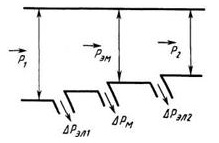How is the efficiency of a transformer determined?
It is known that electrical energy is transmitted over long distances at voltages exceeding the level used by consumers. The use of transformers is necessary in order to convert voltages to the required values, increase the quality of the power transmission process, and also reduce the resulting losses.
Description and principle of operation of the transformer
A transformer is an apparatus for stepping down or stepping up voltage, changing the number of phases, and, in rare cases, changing the frequency of an alternating current.
There are the following types of devices:
- power;
- measuring;
- low power;
- impulse;
- peak transformers.
The static apparatus consists of the following main structural elements: two (or more) windings and a magnetic circuit, which is also called a core. In transformers, voltage is applied to the primary winding, and the secondary is removed already in the converted form. The windings are coupled inductively, by means of a magnetic field in the core.
Along with other converters, transformers have an efficiency factor (abbreviated - efficiency), with a symbol. This ratio is the ratio of the energy effectively used to the energy consumed from the system. It can also be expressed as the ratio of the power consumed by the load to the device consumed from the network. Efficiency refers to one of the paramount parameters characterizing the efficiency of the work performed by the transformer.
Types of losses in the transformer
The process of transferring electricity from the primary winding to the secondary is accompanied by losses. For this reason, not all energy is transferred, but most of it.
The design of the device does not provide for rotating parts, unlike other electric machines. This explains the absence of mechanical losses in it.
So, the device has the following losses:
- electrical, in copper windings;
- magnetic, in steel core.
Energy Diagram and Law of Conservation of Energy
The principle of operation of the device can be schematically shown in the form of an energy diagram, as shown in image 1. The diagram reflects the process of energy transfer, during which electrical and magnetic losses are formed. .

According to the diagram, the formula for determining the effective power P 2 is as follows:
P 2 \u003d P 1 -ΔP el1 -ΔP el2 -ΔP m (1)
where, P 2 is useful, and P 1 is the power consumed by the device from the network.
Denoting the total losses ΔP, the law of conservation of energy will look like: P 1 = ΔP + P 2 (2)
It can be seen from this formula that P 1 is spent on P 2 and also on the total losses ΔP. Hence, the efficiency of the transformer is obtained as a ratio of the output (useful) power to the consumed power (the ratio of P 2 and P 1).
Determination of efficiency
With the required accuracy for calculating the device, pre-derived values of the efficiency can be taken from table No. 1:
As shown in the table, the value of the parameter directly depends on the total power.
Determination of efficiency by direct measurement
The formula for calculating the efficiency can be represented in several ways:
This expression clearly reflects that the value of the transformer efficiency is not more than one, and also not equal to it.
The following expression defines the net power value:
P 2 \u003d U 2 * J 2 * cosφ 2, (4)
where U 2 and J 2 are the secondary voltage and load current, and cosφ 2 is the power factor, the value of which depends on the type of load.
Since P 1 =ΔP+P 2 , formula (3) takes the following form:
The electrical losses of the primary winding ΔP el1n depend on the square of the strength of the current flowing in it. So they should be defined like this:
 (6)
(6)
In its turn:
 (7)
(7)
where r mp is the active winding resistance.
Since the operation of the electromagnetic apparatus is not limited to the nominal mode, determining the degree of current load requires the use of a load factor, which is equal to:
β=J 2 /J 2n, (8)
where J 2n is the rated current of the secondary winding.
From here, we write expressions for determining the current of the secondary winding:
J 2 \u003d β * J 2n (9)
If we substitute this equality into formula (5), we get the following expression:
Note that it is recommended by GOST to determine the efficiency value using the last expression.
Summarizing the information presented, we note that it is possible to determine the efficiency of a transformer by the values of the power of the primary and secondary windings of the apparatus in nominal mode.
Determination of efficiency by an indirect method
Due to the high efficiency values, which can be equal to 96% or more, as well as the uneconomical method of direct measurements, it is not possible to calculate the parameter with a high degree of accuracy. Therefore, its determination is usually carried out by an indirect method.

Summarizing all the obtained expressions, we obtain the following formula for calculating the efficiency:
η \u003d (P 2 / P 1) + ΔP m + ΔP el1 + ΔP el2, (11)
Summing up, it should be noted that a high efficiency indicator indicates the efficient operation of the electromagnetic apparatus. Losses in the windings and core steel, according to GOST, are determined during an experiment, or a short circuit, and measures aimed at reducing them will help to achieve the maximum possible values of the efficiency, which is what you need to strive for.



